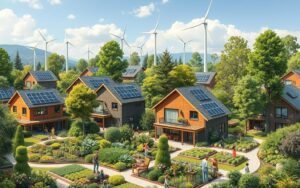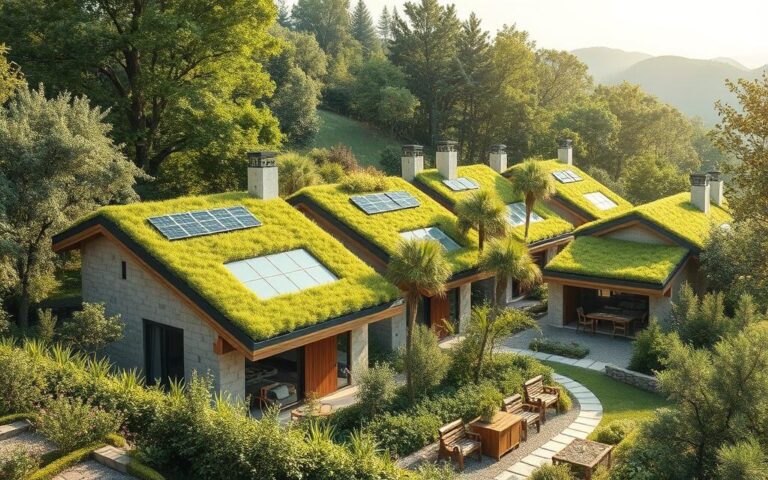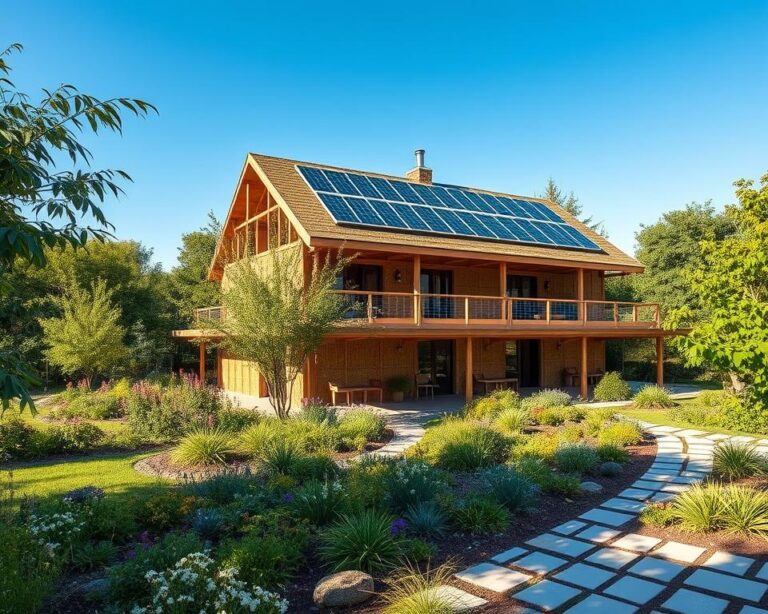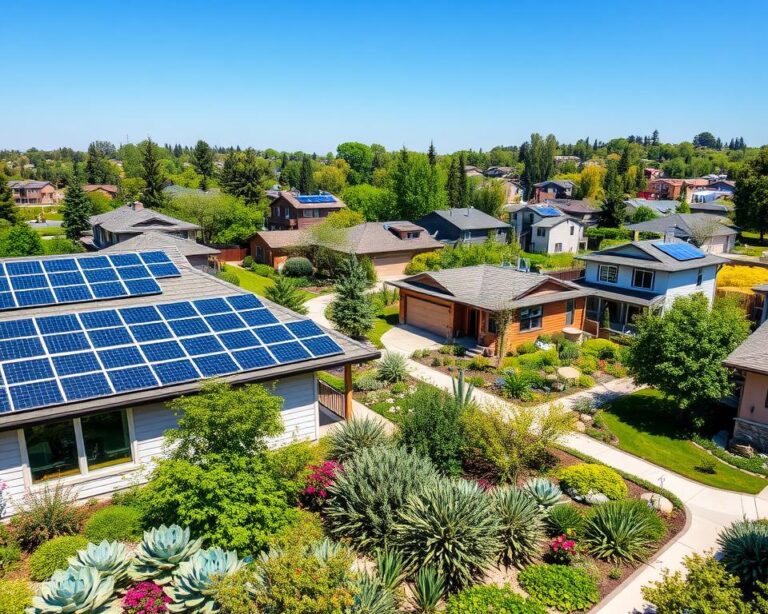Did you know buildings cause about 39% of carbon emissions worldwide? This shows how important sustainable housing is for fighting climate change and making homes healthier. As we learn more about the environment, the need for green homes and sustainable buildings grows. Investing in these homes helps the planet and improves our lives by using less energy and building stronger communities.

Sustainable housing offers more than just environmental benefits. It also brings economic, health, and social gains that make it a great choice for today’s living. Looking into these areas, it’s clear that choosing sustainable architecture is key to a better future.
Understanding Sustainable Housing
In recent years, sustainable housing has become more popular. It’s about building homes that are good for the planet. These homes use less energy and make people feel better.
Definition and Characteristics
Sustainable housing is all about living in harmony with nature. It has a few key features:
- Energy Efficiency: Homes that use much less energy.
- Sustainable Materials: Using materials that are better for the environment.
- Indoor Environmental Quality: Making sure homes have plenty of natural light and fresh air.
- Green Building Features: Using tech like solar panels and insulation to save energy.
Types of Sustainable Housing
There are many types of eco-friendly homes out there. They show new ways to live sustainably:
- LEED-Certified Buildings: Buildings that meet high environmental standards.
- Passive Solar Designs: Homes that use sunlight for warmth and energy.
- Tiny Homes: Small homes that use less material and harm the environment less.
Environmental Benefits
Sustainable housing brings big wins for the planet. It uses new ways and tech to cut down on carbon emissions. This makes homes better for the environment.
These homes use less energy and more green resources. This is key to making our planet healthier.
Reduced Carbon Footprint
Switching to sustainable homes cuts down on carbon emissions a lot. Using solar panels and wind turbines means less fossil fuel use. This leads to:
- Lower energy costs because of smart resource use.
- Less air pollution that harms people and animals.
- Supporting a green lifestyle that fights global warming.
Conservation of Resources
Using resources wisely is crucial in sustainable homes. Good practices cut down on waste and make the most of materials and water. Important steps include:
- Building with recycled materials.
- Using water-saving devices and collecting rainwater.
- Designing homes for more sunlight and air, which cuts energy use.
These steps not only reduce harm to the environment. They also teach us to use resources better. As more homes go green, we all help make the planet more sustainable.
Economic Advantages
Switching to sustainable housing brings many economic benefits. These benefits can greatly help homeowners in the long run. Sustainable building saves money and increases property value, thanks to financial incentives.
Long-term Cost Savings
Sustainable housing offers long-term cost savings. Green homes use energy-efficient systems and renewable energy. This cuts down on energy bills, saving money over time.
These savings add up, making sustainable housing a smart financial choice. Eco-friendly materials also mean less maintenance, adding to the economic benefits.
Increased Property Value
Investing in sustainable housing can also increase property value. Homes with energy-efficient features and sustainable designs attract more buyers. Their eco-friendly aspects make them more appealing.
As demand for green homes grows, so does the return on investment. This makes sustainable housing a wise choice for homeowners.
Access to Incentives and Grants
Government programs and incentives support sustainable housing. Homeowners can get financial help, including grants and tax incentives. Organizations like the U.S. Department of Energy offer aid to reduce initial costs.
This support makes sustainable building more appealing. It highlights the cost savings green homes provide.
| Benefit | Description | Impact on Homeowner |
|---|---|---|
| Long-term Cost Savings | Lower energy bills and maintenance costs resulting from energy-efficient systems. | Increased disposable income and financial stability. |
| Increased Property Value | Higher value due to demand for energy-efficient and eco-friendly features. | Potential for higher resale price and investment return. |
| Access to Incentives | Government grants and tax incentives for sustainable housing practices. | Reduction in upfront costs and financial support for eco-friendly improvements. |
Health and Well-being
Sustainable housing is key to better health. It creates homes that are good for living. These homes use energy wisely and materials that are safe for health.
Improved Indoor Air Quality
Good air inside homes is a big deal in sustainable housing. They use materials that don’t release harmful fumes. They also have systems that bring in fresh air.
This makes the air cleaner. It helps people breathe better and feel healthier. Studies show that fresh air can lower asthma and allergy problems.
Enhanced Natural Lighting
Light from the sun is good for our minds and work. Sustainable homes have big windows and open spaces. This lets in lots of sunlight.
It means less need for artificial lights. People feel happier and more energetic. They say they feel better overall.
| Feature | Traditional Housing | Sustainable Housing |
|---|---|---|
| Indoor Air Quality | Higher pollutant levels | Low-VOC materials, effective ventilation |
| Natural Lighting | Limited windows, often dark | Designs that maximize sunlight exposure |
| Health Impact | Potential respiratory issues, depression | Improved air quality, better mood |
Energy Efficiency
Energy efficiency is key to living sustainably. Homes use new methods and tech to use less energy. Solar panels and wind turbines help by using natural energy.
These systems cut down on the need for old energy sources. They make homes more eco-friendly.
Use of Renewable Energy Sources
Renewable energy makes homes more efficient. Solar panels turn sunlight into electricity. Wind turbines do the same with wind.
More people are choosing these options. They save money and help the planet.
Smart Home Technology
Smart tech is crucial for energy use. It lets people see and control their energy use. Things like smart lights and apps help.
These tools help make better choices. They make living sustainably easier.
| Technology | Function | Benefits |
|---|---|---|
| Solar Panels | Convert sunlight to electricity | Reduces electricity bills, lowers carbon footprint |
| Wind Turbines | Harness wind energy for power | Provides renewable energy, reduces dependence on fossil fuels |
| Smart Thermostats | Automatically adjusts heating and cooling | Enhances comfort, lowers energy costs |
| Energy Monitoring Apps | Track energy consumption patterns | Empowers users to optimize usage |
Using these techs changes how we use energy at home. It leads to a greener living space.
Social Benefits
Sustainable housing brings many social benefits. It helps communities come together and live in harmony with the environment. These projects make places where people can live well and support each other.
They create neighborhoods that are strong and supportive. People can join in local events and activities that help the planet.
Community Development
Sustainable housing focuses on building strong communities. It has green spaces, shared areas, and paths for walking. This encourages people to meet and build friendships.
Being part of a close-knit community can make life better. It can also lead to less crime and more people getting involved in local issues.
Promoting a Sustainable Lifestyle
Sustainable housing also helps people live greener lives. It teaches them to recycle, save energy, and shop locally. These actions help change the way people think about living sustainably.
This change is not just for the community. It affects the whole world. It shows how important it is to take care of our planet every day.
| Social Benefits | Examples |
|---|---|
| Enhanced Community Cohesion | Neighborhood events, shared spaces |
| Stronger Social Ties | Community groups, volunteering opportunities |
| Encouragement of Eco-Friendly Practices | Recycling programs, energy conservation initiatives |
| Increased Civic Engagement | Local decision-making, participation in initiatives |
Government Policies and Support
Government policies are key in promoting sustainable housing. They offer programs and incentives to encourage eco-friendly practices. This helps meet the need for green homes and builds a sustainable culture.
Tax Incentives for Sustainable Housing
Tax incentives for eco-friendly housing can reduce costs. Homeowners get tax breaks for using energy-efficient materials and solar panels. Builders also get tax benefits for sustainable construction. Knowing about these incentives can help maximize benefits.
Local and Federal Programs
Many local and federal programs support sustainable building. They offer grants, loans, and technical help for green projects. For example, the Federal Housing Administration has a program for energy-saving home improvements. State energy offices also provide specific resources, showing a strong national commitment to sustainability.
| Type of Support | Description | Examples |
|---|---|---|
| Tax Incentives | Financial benefits for adopting sustainable practices. | Tax credits for solar installations, energy-efficient appliances. |
| Grants | Funding provided for eco-friendly housing initiatives. | Federal grants for low-income housing upgrades. |
| Low-Interest Loans | Financial assistance at reduced interest rates. | State energy office loans for green retrofitting. |
| Technical Assistance | Guidance and expertise for implementation. | Workshops on energy-efficient building techniques. |
Challenges to Sustainable Housing
The journey to sustainable housing is filled with obstacles. These hurdles affect both homeowners and builders. Key challenges include the high costs and the need for financing eco-friendly homes. Also, navigating the complex world of green building regulations is a big task.
Initial Costs and Financing
One big hurdle is the high upfront cost of eco-friendly homes. These homes use special materials and tech that cost more than traditional homes. Finding financing for these homes can be tough because of the perceived risks and long payback times.
To help, new financing options are popping up. These include green loans and incentives for both private and public projects. These options aim to make the initial costs more manageable, encouraging more people to choose sustainable homes.
Regulatory Hurdles
Green building regulations can be a major challenge. Local laws and building codes might not support eco-friendly designs. This can cause confusion and delays for builders and homeowners.
Meeting these regulations can affect project timelines and budgets. But, some areas are working to change their rules. They want to make it easier to build sustainable homes. Seeing these efforts in action shows how important it is to tackle these regulatory hurdles.

| Challenges | Impact | Potential Solutions |
|---|---|---|
| Initial Costs | Inhibits homeowner investment | Green loans and incentives |
| Financing Eco-friendly Homes | Limited access to funding | Public-private partnerships |
| Regulations for Green Building | Delays in project approval | Revised zoning laws |
Future of Sustainable Housing
The world of sustainable housing is changing fast. People are now more aware of how we affect the environment. They want homes that are good for the planet and look great too.
Modular homes and designs that bring nature inside are becoming popular. These homes are not only eco-friendly but also make people feel connected to the outdoors.
Trends in Sustainable Design
Soon, more homes will be built to be flexible and green. Modular homes are built off-site and put together quickly. This makes them cheaper and more efficient.
Designs that bring nature inside, like living walls and natural light, will become common. These features make homes better to live in and connect us to the outdoors.
Role of Technology in Sustainability
Technology will be key in making homes more sustainable. New energy storage and smart grid tech will help us use energy better. This means we can use more solar and wind power.
Smart home tech will also improve how we manage resources. It will make homes more efficient and easier to live in.
FAQ
What are the benefits of sustainable housing?
Sustainable housing cuts down on energy use and lowers bills. It also improves air quality and reduces carbon footprint. Eco-friendly homes make life better and support health.
How do energy-efficient living solutions work?
Energy-efficient homes use solar power and smart tech. This cuts costs and lessens reliance on fossil fuels. It’s a smart way to save money and the planet.
What are some common features of eco-friendly homes?
Eco-friendly homes use green materials and energy-saving appliances. They also have smart tech, water-saving systems, and designs that let in natural light and air.
How can sustainable architecture impact property value?
Sustainable homes are more sought after, boosting their value. People want homes that save energy and are kind to the planet. This makes these homes more valuable.
Are there any government incentives for eco-friendly housing?
Yes, governments offer tax breaks and grants for green homes. These incentives help lower the cost of building eco-friendly.
What are the health benefits of living in a sustainable home?
Sustainable homes have better air quality and fewer harmful chemicals. They also let in more natural light. This improves health and well-being.
What challenges do homeowners face when investing in sustainable housing?
Homeowners might face high costs for green materials and tech. There can also be financing and code hurdles. These obstacles can slow down green building.
How does sustainable housing contribute to community development?
Sustainable housing fosters community and green living. It encourages people to live in harmony with the environment. This leads to a greener community.
What is the role of technology in sustainable housing?
Technology is key in sustainable housing. It offers new ways to manage energy and improve efficiency. It also helps integrate renewable energy sources.
What future trends should we expect in sustainable housing?
We’ll see new designs like modular homes and biophilic architecture. Smart home tech will also keep getting better. These advancements will make homes more sustainable.




